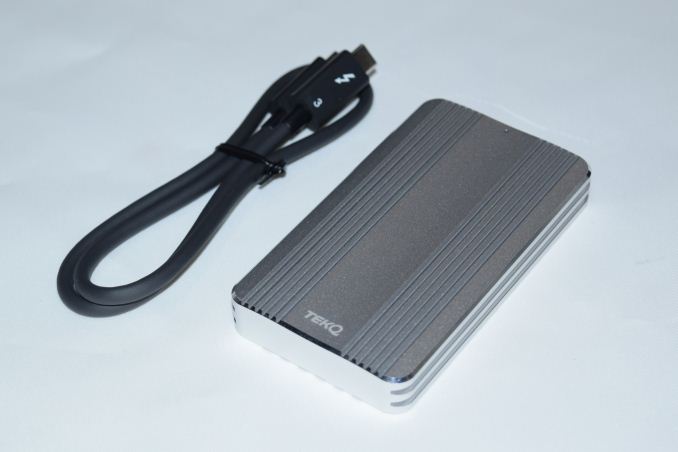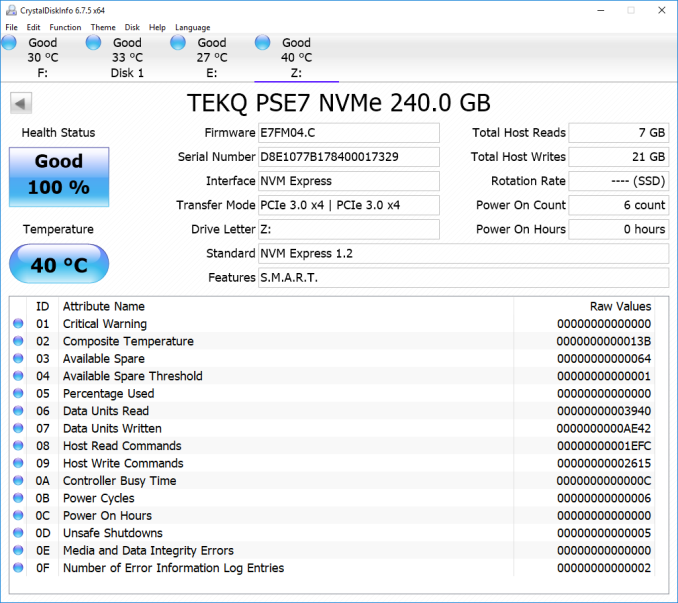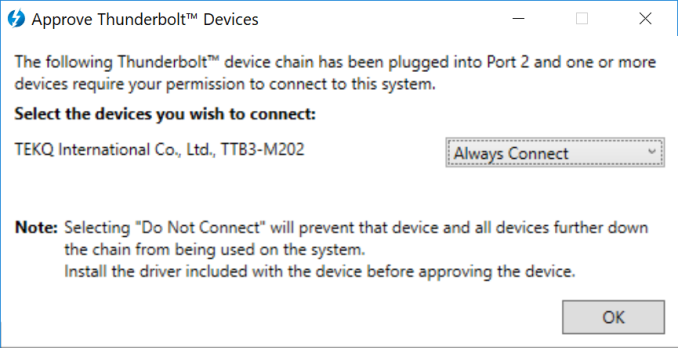TEKQ Rapide Thunderbolt 3 External SSD Review
by Ganesh T S on February 20, 2018 8:00 AM EST- Posted in
- Storage
- SSDs
- DAS
- Thunderbolt 3

Flash-based external direct-attached storage (DAS) devices have evolved rapidly over the last few years. Starting with simple thumb drives that could barely saturate USB 2.0 bandwidth, we now have high-performance external SSDs that take advantage of the USB 3.1 Gen 2 interface to saturate the internal SATA bandwidth. The introduction of PCIe-based SSDs have enabled mass-market storage devices to break the SATA barrier. The proliferation of Thunderbolt 3 (that drives up the available bandwidth by a factor of four compared to USB 3.1 Gen 2) has ensured that the full performance benefits of the internal PCIe interface can be made available in external devices.
A number of high-performance direct-attached storage (DAS) devices have attempted to take advantage of the benefits of Thunderbolt in the last few years. However, they have either required external power adapters (such as the LaCie d2 Thunderbolt 2 SSD Upgrade), or, in the case of bus-powered devices, been held back by an internal SATA SSD (eg.: LaCie Rugged Thunderbolt). The pricing of such devices have also restricted them to the high-end / professional market. In this context, the introduction of a reference platform by Phison at CES 2018 is sure to address the shortcomings of the current external Thunderbolt SSDs in the mainstream market.
Introduction
TEKQ has been in business as a manufacturer of Apple MFI-certified peripherals for some time now. They are new to the direct-attached storage space, but, their first product in that market segment - the Rapide Thunderbolt 3 External SSD - leapfrogs most of the other bus-powered alternatives in the market in terms of both performance and pricing.
The TEKQ Rapide is a 98mm x 45mm x 12mm silver-colored external SSD with an aluminum chassis. It sports a single Thunderbolt 3 interface for both power and data. The port is enabled by the Intel DSL6340 Thunderbolt 3 Controller - note that this belongs to the Alpine Ridge family, and hence, works only with Thunderbolt 3 Type-C ports. On the other side of the DSL6340 is a PCIe 3.0 x4 connection that leads to a M.2 slot capable of accommodating M.2 2260 or 2280 PCIe SSDs. There are no plastic components in the chassis.
There is nothing preventing advanced users from installing their own M.2 PCIe SSDs in the internal M.2 slot. However, TEKQ plans to sell the Rapide in three different capacity points - 240GB, 480GB, and 960GB. Based on our teardown, the internal SSD doesn't seem to be a branded one. Instead, it appears to be a Phison reference design using the E7 controller along with Toshiba's MLC NAND flash.
Unlike similar products such as OWC Envoy Pro EX / EX(VE) that are available for retail purchase right now, TEKQ has opted to go for the crowdfunding route to garner more exposure prior to a wide market release. As a matter of policy, AnandTech does not cover crowdfunding projects. There are very few exceptions - most of the ones that pass our bar are ones where the product is close enough to the launch that manufacturers are ready to have us post a hands-on review of the product. The TEKQ Rapide is one such device. TEKQ's crowdfunding initiative will go live on Feb. 21, 2018.
TEKQ sent over the 240GB variant for review. In addition to the main unit, a 0.5m Thunderbolt 3 cable (certified for 40 Gbps operation) is also bundled.
The TEKQ Rapide is around the size of a credit card, and weighs 135g. With TEKQ's own internal SSD solution, read/write speeds of 2700 MBps / 1500 MBps are claimed, with the random read/write IOPS coming in at 300K/250K respectively.
Prior to looking at the internals, CrystalDiskInfo provides some insights.
Even though CrystalDiskInfo puts only SMART in the features section, we will see later on that TRIM is also supported. The Thunderbolt link is essentially invisible to the tool, with NVM Express listed as the interface. For all practical purposes, the TEKQ Rapide SSD is a PCIe 3.0 x4 NVMe SSD in the system.
Internal Hardware
The TEKQ Rapide is easy to disassemble, with four screws hidden under the rubber feet on the underside of the chassis. The gallery below has pictures of the chassis as well as the internal design and M.2 SSD. The Phison controller and the Toshiba MLC flash are easily seen in the M.2 SSD.
The design includes thermal pads for both the M.2 SSD and the Thunderbolt 3 controller. As we shall see later on, the thermal solution is very effective in keeping the internal temperatures under check even under stressful conditions beyond what a consumer-focused DAS unit might endure.
Usage Impressions
The TEKQ Rapide is plug-and-play except for the small matter of allowing Thunderbolt security to allow one's system to act as a host for the device.
Once approved (needs to be done only once per system if the 'Always Connect' option is chosen), the device mounts as a exFAT volume. This allows for compatibility with both Mac and Windows devices. Since the Thunderbolt 3 / NVMe SSD breezed through our benchmarks in very little time, we were able to evaluate the unit with the volume formatted in exFAT and NTFS.
Unlike some of the other portable SSDs in the market that come with value-adds such as hardware encryption support, the TEKQ is currently keeping it simple. Despite the underlying platform (Phison E7 reference design with Toshiba 15nm MLC flash) supporting AES-256 with TCG / Opal 2.0, the feature doesn't have any user-friendly way to get activated.



















33 Comments
View All Comments
jabber - Tuesday, February 20, 2018 - link
I always find the idea of these devices far better then the reality. You get your 3000MBps storage device plug it in all excited, hit 'copy/paste' and feel your smile disappear as 600GB of kb sized files reduce the speed to 60kbps and 5 hours remaining...Ian Cutress - Tuesday, February 20, 2018 - link
For our CPU Compile test, it involves ~250k small files. Of course, that's a pain to copy over the NAS for each new system build we test, so I keep the files zipped on the NAS, copy the zip file over to the new test system, and decompress locally. Scripted, of course.Pinn - Tuesday, February 20, 2018 - link
I've worked on file systems (clustered server). There's not a way around this. Sorry!jabber - Tuesday, February 20, 2018 - link
I think it's a problem that needs addressing. More and more applications are creating GBs of microfiles that just cripple performance.Mikewind Dale - Tuesday, February 20, 2018 - link
"Adding a user-friendly way to activate the hardware encryption capabilities of the internal SSD would be a nice feature to have"Can you check whether it at least uses hardware encryption with other encryption utilities? E.g. Windows 10 Pro Bitlocker?
My understanding is that if you enable Bitlocker, then either the drive will spend several hours encrypting (software encryption) or else it will enable "instantly" (hardware encryption). I think you can also go into the Bitlocker settings to see which kind of encryption has been used.
It would be interesting to see if hardware encryption can at least be used in the "background" (so to speak) with some other encryption utility.
OFelix - Tuesday, February 20, 2018 - link
"We were able to successfully activate TRIM on the TEKQ Rapide."Is this something a 'normal' user would have to enable themselves? Why is it not on by default?
Is it covered in the setup guide (since this is a pre-retail product you may not be able to answer this)?
ganeshts - Tuesday, February 20, 2018 - link
If you are running exFAT - I am not sure TRIM gets activated (or, if it is even necessary).If you are running NTFS - the OS will take care of the TRIM as long as the drive enters idle with the device powered and connected. When I mention 'successfully activate' - it was in reference to the fact that I could manually trigger a TRIM command (check the screenshot).
The takeaway is : For normal users, as long as the drive is formatted in NTFS, and they are using Windows - the TRIM feature is taken care of. I can't comment about Macs, though.
WinterCharm - Tuesday, February 20, 2018 - link
Hey Ganesh, Any chance you plan to review the Atom Glyph SSD's? They're blade style SSD's and I'd be really interested in whether they're worth using.ganeshts - Tuesday, February 20, 2018 - link
The Atom Glyph looks interesting for sure. If their PR team reaches out, I don't see any issues with reviewing them. Currently, I have a huge backlog to address in terms of review units, but I will think about reaching out once that is addressed.Hurr Durr - Tuesday, February 20, 2018 - link
Considering external SSDs, does anybody here have any experience with M.2 USB3 enclosures? How are speeds, do they overheat?